Regional Assessment of Carbon Pool Response to Intensive Silvicultural Practices in Loblolly Pine Plantations
Abstract
:1. Introduction
2. Methods
2.1. Experimental Design
2.2. Sample Collection for Ecosystem C Pools
3. Data Analysis
4. Results
4.1. C Pools
4.2. Comparisons between Treatments
4.3. Models of C Pool Dynamics
5. Discussion
5.1. Mineral Soil C
5.2. Unmeasured C Pools
5.3. Management Implications
6. Conclusions
Supplementary Materials
Author Contributions
Funding
Data Availability Statement
Acknowledgments
Conflicts of Interest
Appendix A
| Treatment | TPH | SI | SDI | Age |
|---|---|---|---|---|
| Control | 1221 ± 75 | 21.9 ± 0.3 | 773 ± 38 | 18 ± 1.2 |
| W | 1160 ± 52 | 23.1 ± 0.9 | 690 ± 83 | 15 ± 2.1 |
| T | 637 ± 76 | 22.2 ± 0.4 | 457 ± 29 | 19 ± 0.7 |
| TW | 461 ± 50 | 22.4 ± 0.5 | 406 ± 26 | 19 ± 0.7 |
| F | 1094 ± 94 | 22.0 ± 0.6 | 687 ± 60 | 20 ± 1.6 |
| FW | 1323 ± 109 | 23.7 ± 0.5 | 788 ± 43 | 18 ± 1.4 |
| FT | 553 ± 64 | 22.6 ± 0.4 | 423 ± 27 | 19 ± 0.8 |
| FTW | 495 ± 51 | 23.3 ± 0.3 | 440 ± 22 | 20 ± 0.6 |
| Intensity | ||||
| High | 1697 ± 93 | 26.9 ± 0.3 | 902 ± 25 | 14 ± 0.4 |
| Low | 1887 ± 191 | 25.8 ± 0.5 | 823 ± 50 | 14 ± 0.2 |
Appendix B
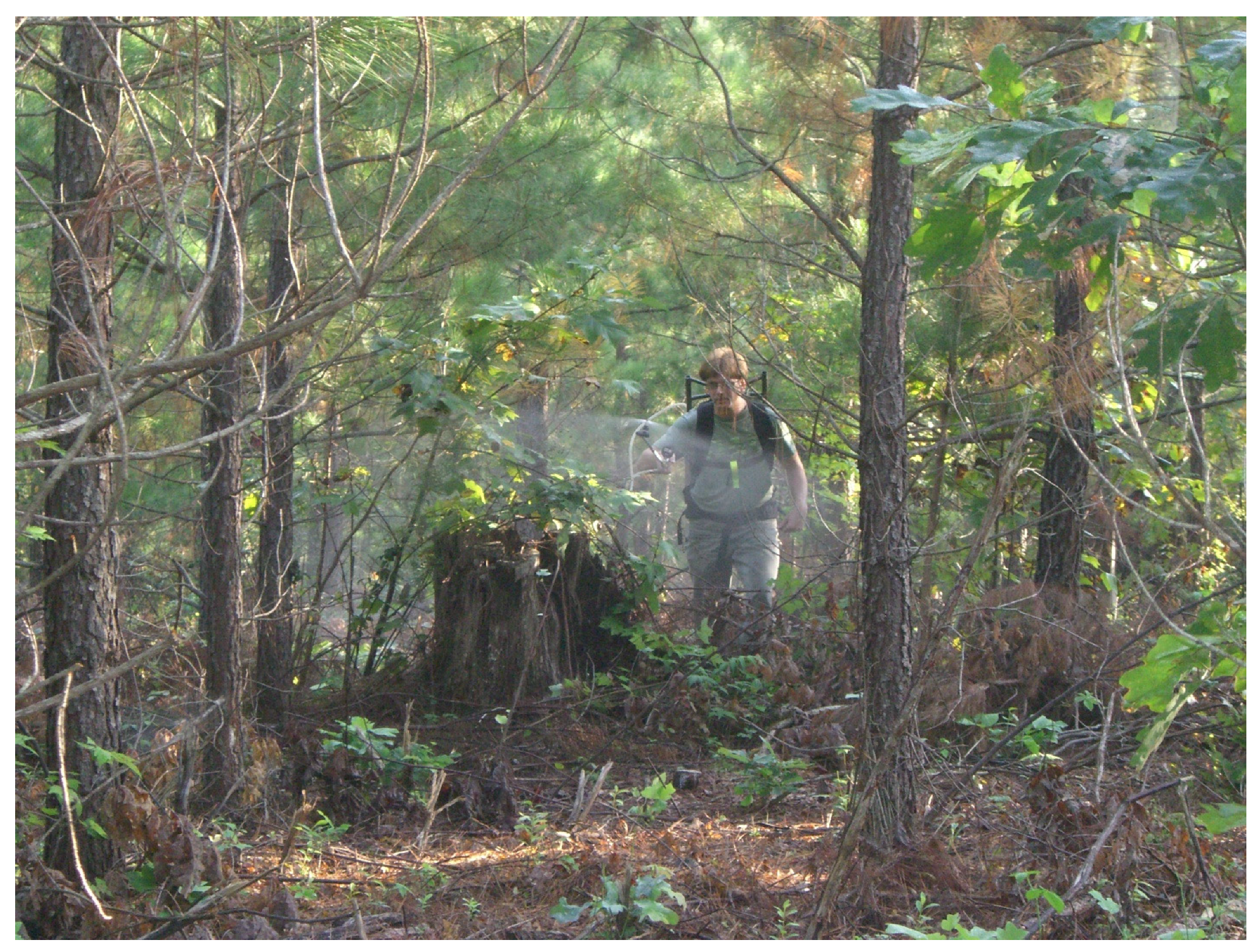
Appendix C
| Thinning (T) Comparisons | ||||||||
| Depth (cm) | T | No T | T (+W) | No T (+W) | T (+F) | No T (+F) | T (+WF) | No T (+WF) |
| 0–10 | 19.4 ± 1.3 | 19.5 ± 1.2 | 25.1 ± 4.3 | 27.4 ± 5.1 | 26.1 ± 4.3 | 26.4 ± 5.1 | 28.0 ± 2.2 | 29.4 ± 2.9 |
| 10–20 | 10.3 ± 0.6 | 9.7 ± 0.8 | 14.4 ± 3.2 | 21.1 ± 5.2 | 15.4 ± 3.2 | 14.4 ± 5.2 | 19.3 ± 2.6 | 19.7 ± 3.6 |
| 20–50 | 19.7 ± 2.3 | 16.6 ± 1.1 | 24.4 ± 6.1 | 32.6 ± 5.9 | 19.4 ± 6.1 | 25.6 ± 5.9 | 27.5 ± 2.6 | 29.0 ± 3.9 |
| 50–100 | 17.7 ± 2.3 | 15.5 ± 1.9 | 18.2 ± 3.3 | 30.6 ± 7.6 | 16.9 ± 3.3 | 25.7 ± 7.6 | 25.2 ± 4.3 | 23.2 ± 2.4 |
| 0–100 | 67.0 ± 1.6 | 61.3 ± 1.2 | 82.2 ± 4.2 | 111.9 ± 5.9 | 78.3 ± 4.2 | 92.2 ± 5.9 | 100.0 ± 3.0 | 101.3 ± 3.2 |
| N = 23 | N = 7 | N = 11 | N = 20 | |||||
| Weed Control (W) Comparisons | ||||||||
| Depth (cm) | W (+T) | No W (+T) | W (+TF) | No W (+TF) | ||||
| 0–10 | 17.7 ± 2.2 | 18.3 ± 2.3 | 17.9 ± 1.8 | 16.5 ± 1.2 | ||||
| 10–20 | 9.0 ± 1.2 | 8.9 ± 1.1 | 9.4 ± 1.2 | 9.7 ± 1.3 | ||||
| 20–50 | 15.9 ± 2.2 | 19.7 ± 3.9 | 15.0 ± 2.1 | 15.7 ± 2.0 | ||||
| 50–100 | 16.3 ± 2.2 | 18.5 ± 3.8 | 14.8 ± 2.4 | 16.3 ± 2.0 | ||||
| 0–100 | 58.9 ± 2.8 | 65.4 ± 2.0 | 57.0 ± 1.9 | 58.1 ± 1.6 | ||||
| N = 11 | N = 11 | |||||||
| Fertilization (F) Comparisons | ||||||||
| Depth (cm) | F (+T) | No F (+T) | F (+W) | No F (+W) | F (+TW) | No F (+TW) | ||
| 0–10 | 21.7 ± 2.0 | 23.7 ± 2.3 | 32.2 ± 4.3 | 29.6 ± 4.0 | 21.4 ± 1.6 | 19.7 ± 1.7 | ||
| 10–20 | 11.4 ± 1.2 | 11.5 ± 1.2 | 17.2 ± 1.7 | 18.4 ± 3.2 | 11.6 ± 1.3 | 10.6 ± 0.9 | ||
| 20–50 | 18.9 ± 1.8 | 21.4 ± 2.5 | 35.9 ± 6.9 | 31.7 ± 4.3 | 19.7 ± 2.1 | 19.7 ± 2.3 | ||
| 50–100 | 16.7 ± 1.5 | 18.5 ± 2.9 | 23.3 ± 2.9 | 38.8 ± 11.6 | 24.2 ± 3.8 | 21.8 ± 3.2 | ||
| 0–100 | 68.6 ± 1.6 | 75.2 ± 2.3 | 108.6 ± 3.9 | 118.4 ± 5.8 | 76.8 ± 2.2 | 71.7 ± 2.0 | ||
| N = 19 | N = 9 | N = 26 | ||||||
| Intensity Comparison | ||||||||
| Depth (cm) | High | Low | ||||||
| 0–10 | 22.9 ± 1.4 | 21.8 ± l.5 | ||||||
| 10–20 | 14.4 ± 1.0 | 14.0 ± 1.0 | ||||||
| 20–50 | 23.0 ± 1.9 | 23.6 ± 2.1 | ||||||
| 50–100 | 24.7 ± 5.1 | 25.4 ± 3.7 | ||||||
| 0–100 | 85.0 ± 2.4 | 84.8 ± 2.1 | ||||||
| N = 18 | ||||||||
Appendix D
| Thinning (T) Comparisons | ||||||||
| T | No T | T (+W) | No T (+W) | T (+F) | No T (+F) | T (+WF) | No T (+WF) | |
| Biomass | 64.4 ± 3.2 | 100.9 ± 4.6 | 64.1 ± 7.8 | 98.1 ± 11.6 | 64.5 ± 6.9 | 103.0 ± 10.6 | 75.3 ± 5.5 | 108.3 ± 5.5 |
| Detritus | 10.6 ± 1.2 | 12.9 ± 1.3 | 11.8 ± 1.8 | 15.6 ± 1.3 | 14.1 ± 2.0 | 17.1 ± 2.1 | 15.4 ± 1.6 | 15.8 ± 1.8 |
| Plots | N = 22 | N = 7 | N = 11 | N = 20 | ||||
| Age | 20 | 18 | 21 | 21 | ||||
| Weed Control (W) Comparisons | ||||||||
| W (+T) | No W (+T) | W (+TF) | No W (+TF) | |||||
| Biomass | 71.0 ± 4.8 | 68.7 ± 4.3 | 73.6 ± 4.8 | 70.4 ± 4.9 | ||||
| Detritus | 10.2 ± 1.4 | 10.3 ± 1.4 | 11.3 ± 0.9 | 10.2 ± 1.4 | ||||
| Plots | N = 10 | N = 10 | ||||||
| Age | 20 | 21 | ||||||
| Fertilization (F) Comparisons | ||||||||
| F | No F | F | No F | F | No F | |||
| (+T) | (+T) | (+W) | (+W) | (+TW) | (+TW) | |||
| Biomass | 63.8 ± 4.4 | 63.6 ± 3.6 | 70.6 ± 15.1 | 66.6 ± 14.3 | 63.8 ± 3.4 | 58.1 ± 3.7 | ||
| Detritus | 11.2 ± 1.2 | 11.0 ± 1.2 | 13.1 ± 1.5 | 12.9 ± 1.9 | 12.1 ± 1.2 | 10.1 ± 0.9 | ||
| Plots | N = 18 | N = 9 | N = 24 | |||||
| Age | 19 | 14 | 19 | |||||
| Intensity Comparison | ||||||||
| High | Low | |||||||
| Biomass | 108.6 ± 6.5 | 87.2 ± 5.6 | ||||||
| Detritus | 18.2 ± 1.6 | 16.6 ± 1.8 | ||||||
| Plots | N = 21 | |||||||
| Age | 14 | |||||||
Appendix E
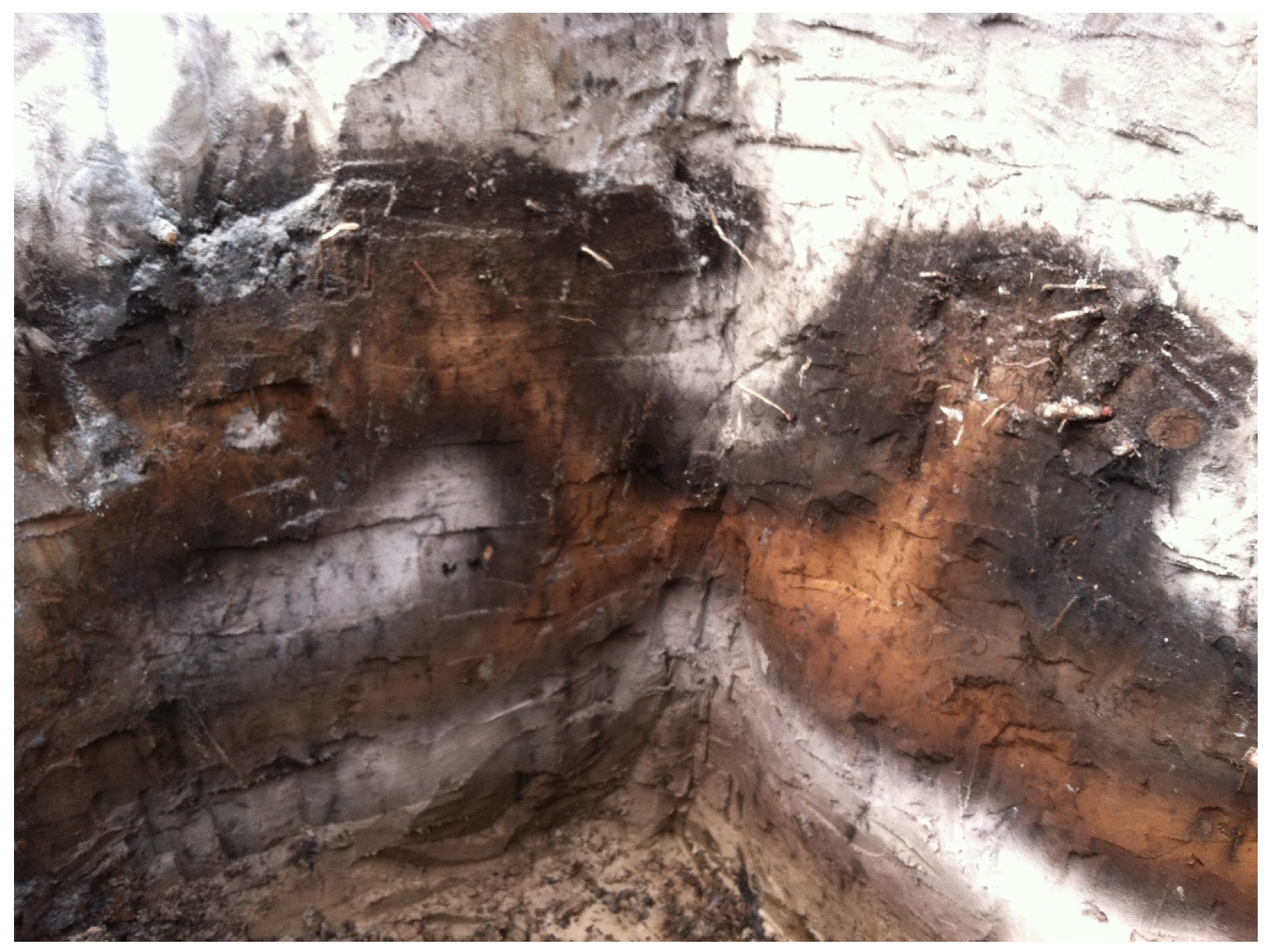
References
- Pan, Y.; Birdsey, R.A.; Fang, J.; Houghton, R.; Kauppi, P.E.; Kurz, W.A.; Phillips, O.L.; Shvidenko, A.; Lewis, S.L.; Canadell, J.G.; et al. A Large and Persistent Carbon Sink in the World’s Forests. Science 2011, 333, 988–993. [Google Scholar] [CrossRef] [PubMed] [Green Version]
- Payn, T.; Carnus, J.M.; Freer-Smith, P.; Kimberley, M.; Kollert, W.; Liu, S.; Orazio, C.; Rodriguez, L.C.; Silva, L.N.; Wingfield, M.J. Changes in planted forests and future global implications. For. Ecol. Manag. 2015, 352, 57–67. [Google Scholar] [CrossRef] [Green Version]
- Fox, T.R.; Allen, H.L.; Albaugh, T.J.; Rubilar, R.; Carlson, C.A. Tree Nutrition and Forest Fertilization of Pine Plantations in the Southern United States. South. J. Appl. For. 2007, 31, 5–11. [Google Scholar] [CrossRef] [Green Version]
- McKinley, D.C.; Ryan, M.G.; Birdsey, R.A.; Giardina, C.P.; Harmon, M.E.; Heath, L.S.; Houghton, R.A.; Jackson, R.B.; Mor-rison, J.F.; Murray, B.C.; et al. A synthesis of current knowledge on forests and carbon storage in the United States. Ecol. Appl. 2011, 21, 1902–1924. [Google Scholar] [CrossRef] [PubMed] [Green Version]
- Favero, A.; Mendelsohn, R.; Sohngen, B. Using forests for climate mitigation: Sequester carbon or produce woody biomass? Clim. Chang. 2017, 144, 195–206. [Google Scholar] [CrossRef]
- Nave, L.E.; Domke, G.M.; Hofmeister, K.L.; Mishra, U.; Perry, C.H.; Walters, B.F.; Swanston, C.W. Reforestation can sequester two petagrams of carbon in US topsoils in a century. Proc. Natl. Acad. Sci. USA 2018, 115, 2776–2781. [Google Scholar] [CrossRef] [Green Version]
- Johnson, D.W.; Curtis, P.S. Effects of forest management on soil C and N storage: Meta analysis. For. Ecol. Manag. 2001, 140, 227–238. [Google Scholar] [CrossRef]
- Mayer, M.; Prescott, C.E.; Abaker, W.E.; Augusto, L.; Cécillon, L.; Ferreira, G.W.; James, J.; Jandl, R.; Katzensteiner, K.; Laclau, J.-P.; et al. Tamm Review: Influence of forest management activities on soil organic carbon stocks: A knowledge synthesis. For. Ecol. Manag. 2020, 466, 118127. [Google Scholar] [CrossRef]
- Koricheva, J.; Gurevitch, J. Uses and misuses of meta-analysis in plant ecology. J. Ecol. 2014, 102, 828–844. [Google Scholar] [CrossRef]
- Wear, D.N.; Greis, J.G. The Southern Forest Futures Project: Technical Report; Southern Research Station, Forest Service, U.S. Department of Agriculture: Asheville, NC, USA, 2013. [CrossRef]
- Ross, C.W.; Grunwald, S.; Vogel, J.G.; Markewitz, D.; Jokela, E.J.; Martin, T.A.; Bracho, R.; Bacon, A.R.; Brungard, C.W.; Xiong, X. Accounting for two-billion tons of stabilized soil carbon. Sci. Total Environ. 2020, 703, 134615. [Google Scholar] [CrossRef]
- Smith, J.E.; Domke, G.M.; Nichols, M.C.; Walters, B.F. Carbon stocks and stock changes on federal forest lands of the United States. Ecosphere 2019, 10, e02637. [Google Scholar] [CrossRef]
- Hoover, C.M.; Smith, J.E. Current aboveground live tree carbon stocks and annual net change in forests of conterminous United States. Carbon Balance Manag. 2021, 16, 17. [Google Scholar] [CrossRef]
- Han, F.X.; Plodinec, M.J.; Su, Y.; Monts, D.L.; Li, Z. Terrestrial carbon pools in southeast and south-central United States. Clim. Chang. 2007, 84, 191–202. [Google Scholar] [CrossRef]
- Albaugh, T.J.; Vance, E.D.; Gaudreault, C.; Fox, T.R.; Allen, H.L.; Stape, J.L.; Rubilar, R. Carbon Emissions and Sequestration from Fertilization of Pine in the Southeastern United States. For. Sci. 2012, 58, 419–429. [Google Scholar] [CrossRef]
- McKeand, S.E. The Evolution of a Seedling Market for Genetically Improved Loblolly Pine in the Southern United States. J. For. 2019, 117, 293–301. [Google Scholar] [CrossRef]
- Aspinwall, M.; McKeand, S.; King, J.S. Carbon Sequestration from 40 Years of Planting Genetically Improved Loblolly Pine across the Southeast United States. For. Sci. 2012, 58, 446–456. [Google Scholar] [CrossRef]
- Shan, J.; Morris, L.A.; Hendrick, R.L. The effects of management on soil and plant carbon sequestration in slash pine plantations. J. Appl. Ecol. 2001, 38, 932–941. [Google Scholar] [CrossRef]
- Vogel, J.G.; Suau, L.J.; Martin, T.A.; Jokela, E.J. Long-term effects of weed control and fertilization on the carbon and nitrogen pools of a slash and loblolly pine forest in north-central Florida. Can. J. For. Res. 2011, 41, 552–567. [Google Scholar] [CrossRef]
- Tumushime, I.; Vogel, J.G.; Minor, M.N.; Jokela, E.J. Effects of Fertilization and Competition Control on Tree Growth and C, N, and P Dynamics in a Loblolly Pine Plantation in North Central Florida. Soil Sci. Soc. Am. J. 2019, 83, 242–251. [Google Scholar] [CrossRef]
- Elbert, L.L., Jr. Checklist of United States Trees (Native and Naturalized); Ag. Handb. 541; Department of Agriculture: Washington, DC, USA, 1979; 375p.
- Neary, D.; Rockwood, D.; Comerford, N.; Swindel, B.; Cooksey, T. Importance of weed control, fertilization, irrigation, and genetics in slash and loblolly pine early growth on poorly drained spodosols. For. Ecol. Manag. 1990, 30, 271–281. [Google Scholar] [CrossRef]
- Gonzalez-Benecke, C.A.; Teskey, R.O.; Martin, T.A.; Jokela, E.J.; Fox, T.R.; Kane, M.B.; Noormets, A. Regional validation and improved parameterization of the 3-PG model for Pinus taeda stands. For. Ecol. Manag. 2016, 361, 237–256. [Google Scholar] [CrossRef] [Green Version]
- Johnsen, K.H.; Wear, D.N.; Oren, R.; Teskey, R.O.; Sanchez, F.; Will, R.E.; Butnor, J.; Markewitz, D.; Richter, D.; Rials, T.; et al. Carbon sequestration and southern pine forests. J. For. 2001, 99, 14–21. [Google Scholar]
- Diéguez-Aranda, U.; Burkhart, H.E.; Amateis, R. Dynamic site model for loblolly pine (Pinus taeda L.) plantations in the United States. For. Sci. 2006, 52, 262–272. [Google Scholar]
- Jenkins, J.C.; Chojnacky, D.C.; Heath, L.S.; Birdsey, R.A. National-scale biomass estimators for United States tree species. For. Sci. 2003, 49, 12–35. [Google Scholar]
- Woodall, C.W.; Monleon, V.J. Sampling Protocol, Estimation, and Analysis Procedures for the Down Woody Materials Indicator of the Fia Program; Northern Research Station, Forest Service, U.S. Department of Agriculture: Newtown Square, PA, USA, 2008. [CrossRef] [Green Version]
- Ditzler, C.; Scheffe, K.; Monger, H.C. (Eds.) Soil Science Division Staff. Soil Survey Manual; USDA Handbook Government Printing Office: Washington, DC, USA, 2017.
- Holm, S. A simple sequentially rejective multiple test procedure. Scand. J. Stat. 1979, 6, 65–70. [Google Scholar]
- Efron, B.; Hastie, T.; Johnstone, I.; Tibshirani, R. Least angle regression. Ann. Stat. 2004, 32, 407–499. [Google Scholar] [CrossRef] [Green Version]
- Hocking, R.R. The Analysis and Selection of Variables in Linear Regression. Biometrics 1976, 32, 1–50. [Google Scholar] [CrossRef]
- Ruiz-Peinado, R.; Bravo-Oviedo, A.; López-Senespleda, E.; Bravo, F.; del Rio, M. Forest management and carbon sequestration in the Mediterranean region: A review. For. Syst. 2017, 26, eR04S. [Google Scholar] [CrossRef]
- Thomas, R.Q.; Jersild, A.L.; Brooks, E.B.; Thomas, V.A.; Wynne, R.H. A mid-century ecological forecast with partitioned uncertainty predicts increases in loblolly pine forest productivity. Ecol. Appl. 2018, 28, 1503–1519. [Google Scholar] [CrossRef]
- Zhao, D.; Kane, M.; Teskey, R.; Fox, T.R.; Albaugh, T.J.; Allen, H.; Rubilar, R. Maximum response of loblolly pine plantations to silvicultural management in the southern United States. For. Ecol. Manag. 2016, 375, 105–111. [Google Scholar] [CrossRef] [Green Version]
- Drum, C.G.; Vogel, J.G.; Gezan, S.A.; Jokela, E.J. Belowground processes for two loblolly pine (Pinus taeda L.) families respond differently to the intensity of plantation management. For. Ecol. Manag. 2019, 441, 293–301. [Google Scholar] [CrossRef] [Green Version]
- Jokela, E.J.; Martin, T.A.; Vogel, J.G. Twenty-five years of intensive forest management with southern pines: Important lessons learned. J. For. 2010, 108, 338–347. [Google Scholar]
- Vogel, J.G.; He, D.; Jokela, E.J.; Hockaday, W.; Schuur, E.A. The effect of fertilization levels and genetic deployment on the isotopic signature, constituents, and chemistry of soil organic carbon in managed loblolly pine (Pinus taeda L.) forests. For. Ecol. Manag. 2015, 355, 91–100. [Google Scholar] [CrossRef]
- Gonzalez-Benecke, C.A.; Jokela, E.J.; Martin, T.A. Modeling the Effects of Stand Development, Site Quality, and Silviculture on Leaf Area Index, Litterfall, and Forest Floor Accumulations in Loblolly and Slash Pine Plantations. For. Sci. 2012, 58, 457–471. [Google Scholar] [CrossRef]
- Burkhart, H.E.; Brooks, E.B.; Dinon-Aldridge HSabatia, C.O.; Gyawali, N.; Wynne, R.H.; Thomas, V.A. Regional simulations of loblolly pine productivity with CO2 enrichment and changing climate scenarios. For. Sci. 2018, 64, 349–357. [Google Scholar] [CrossRef]
- Gonzalez-Benecke, C.A.; Teskey, R.O.; Dinon-Aldridge, H.; Martin, T.A. Pinus taeda forest growth predictions in the 21st century vary with site mean annual temperature and site quality. Glob. Chang. Biol. 2017, 23, 4689–4705. [Google Scholar] [CrossRef] [PubMed]
- Sabatia, C.O.; Burkhart, H.E. Predicting site index of plantation loblolly pine from biophysical variables. For. Ecol. Manag. 2014, 326, 142–156. [Google Scholar] [CrossRef]
- Subedi, S.; Fox, T.R. Predicting Loblolly Pine Site Index from Soil Properties Using Partial Least-Squares Regression. For. Sci. 2016, 62, 449–456. [Google Scholar] [CrossRef] [Green Version]
- Parresol, B.; Scott, D.; Zarnoch, S.; Edwards, L.; Blake, J. Modeling forest site productivity using mapped geospatial attributes within a South Carolina Landscape, USA. For. Ecol. Manag. 2017, 406, 196–207. [Google Scholar] [CrossRef]
- Jokela, E.J.; Martin, T.A. Effects of ontogeny and soil nutrient supply on production, allocation, and leaf area efficiency in loblolly and slash pine stands. Can. J. For. Res. 2000, 30, 1511–1524. [Google Scholar] [CrossRef]
- Subedi, P.; Jokela, E.J.; Vogel, J.G. Inter-Rotational Effects of Fertilizer and Herbicide Treatments on the Understory Vegetation Community in Juvenile Loblolly Pine (Pinus taeda L.) Stands. For. Sci. 2017, 63, 459–473. [Google Scholar] [CrossRef] [Green Version]
- Sharma, M.; Amateis, R.L.; Burkhart, H.E. Top height definition and its effect on site index determination in thinned and unthinned loblolly pine plantations. For. Ecol. Manag. 2002, 168, 163–175. [Google Scholar] [CrossRef]
- Gonzalez-Benecke, C.A.; Martin, T.A.; Jokela, E.J.; De La Torre, R. A Flexible Hybrid Model of Life Cycle Carbon Balance for Loblolly Pine (Pinus taeda L.) Management Systems. Forests 2011, 2, 749–776. [Google Scholar] [CrossRef] [Green Version]
- Aguilos, M.; Mitra, B.; Noormets, A.; Minick, K.; Prajapati, P.; Gavazzi, M.; Sun, G.; McNulty, S.; Li, X.; Domec, J.-C.; et al. Long-term carbon flux and balance in managed and natural coastal forested wetlands of the Southeastern USA. Agric. For. Meteorol. 2020, 288–289, 108022. [Google Scholar] [CrossRef]
- Bracho, R.; Starr, G.; Gholz, H.L.; Martin, T.A.; Cropper, W.P.; Loescher, H.W. Controls on carbon dynamics by ecosystem structure and climate for southeastern U.S. slash pine plantations. Ecol. Monogr. 2012, 82, 101–128. [Google Scholar] [CrossRef]
- Gholz, H.L.; Fisher, R.F. Organic Matter Production and Distribution in Slash Pine (Pinus elliottii) Plantations. Ecology 1982, 63, 1827. [Google Scholar] [CrossRef]
- Morris, L.A.; Lowery, R.F. Influence of Site Preparation on Soil Conditions Affecting Stand Establishment and Tree Growth. South. J. Appl. For. 1988, 12, 170–178. [Google Scholar] [CrossRef]
- Ontl, T.A.; Janowiak, M.K.; Swanston, C.W.; Daley, J.; Handler, S.; Cornett, M.; Hagenbuch, S.; Handrick, C.; McCarthy, L.; Patch, N. Forest Management for Carbon Sequestration and Climate Adaptation. J. For. 2019, 118, 86–101. [Google Scholar] [CrossRef] [Green Version]
- Rifai, S.W.; Markewitz, D.; Borders, B.E. Twenty years of intensive fertilization and competing vegetation suppression in loblolly pine plantations: Impacts on soil C, N, and microbial biomass. Soil Biol. Biochem. 2010, 42, 713–723. [Google Scholar] [CrossRef]
- Echeverría, M.E.; Markewitz, D.; Morris, L.A.; Hendrick, R.L. Soil Organic Matter Fractions under Managed Pine Plantations of the Southeastern USA. Soil Sci. Soc. Am. J. 2004, 68, 950–958. [Google Scholar] [CrossRef]
- Sartori, F.; Markewitz, D.; Borders, B.E. Soil carbon storage and nitrogen and phosphorous availability in loblolly pine plantations over 4 to16 years of herbicide and fertilizer treatments. Biogeochemistry 2007, 84, 13–30. [Google Scholar] [CrossRef]
- Harding, R.B.; Jokela, E.J. Long-Term Effects of Forest Fertilization on Site Organic Matter and Nutrients. Soil Sci. Soc. Am. J. 1994, 58, 216–221. [Google Scholar] [CrossRef]
- Jurgensen, M.; Tarpey, R.; Pickens, J.; Kolka, R.; Palik, B. Long-term effect of silvicultural thinnings on soil carbon and nitro-gen pools. Soil Sci. Soc. Am. J. 2012, 76, 1418. [Google Scholar] [CrossRef]
- Powers, R.F.; Busse, M.D.; McFarlane, K.; Zhang, J.; Young, D.H. Long-term effects of silviculture on soil carbon storage: Does vegetation control make a difference? Forestry 2013, 86, 47–58. [Google Scholar] [CrossRef] [Green Version]
- Schrumpf, M.; Schulze, E.D.; Kaiser, K.; Schumacher, J. How accurately can soil organic carbon stocks and stock changes be quantified by soil inventories? Biogeosciences 2011, 8, 1193–1212. [Google Scholar] [CrossRef] [Green Version]
- Shi, Z.; Allison, S.D.; He, Y.; Levine, P.A.; Hoyt, A.M.; Beem-Miller, J.; Zhu, Q.; Wieder, W.R.; Trumbore, S.; Randerson, J.T. The age distribution of global soil carbon inferred from radiocarbon measurements. Nat. Geosci. 2020, 13, 555–559. [Google Scholar] [CrossRef]
- Samuelson, L.; Mathew, R.; Stokes, T.; Feng, Y.; Aubrey, D.; Coleman, M. Soil and microbial respiration in a loblolly pine plantation in response to seven years of irrigation and fertilization. For. Ecol. Manag. 2009, 258, 2431–2438. [Google Scholar] [CrossRef]
- Zhang, Y.; Vogel, J.G.; Meek, C.; Will, R.; Wilson, D.; West, J. Wood decomposition by microbes and macroinvertebrates, and soil CO2 efflux vary in response to throughfall reduction and fertilization in a loblolly pine (Pinus taeda L.) plantation. For. Ecol. Manag. 2016, 382, 10–20. [Google Scholar] [CrossRef] [Green Version]
- Bracho, R.; Vogel, J.G.; Will, R.; Noormets, A.; Samuelson, L.J.; Jokela, E.J.; Gonzalez-Benecke, C.A.; Gezan, S.A.; Markewitz, D.; Seiler, J.R.; et al. Carbon accumulation in loblolly pine plantations is increased by fertilization across a soil moisture availability gradient. For. Ecol. Manag. 2018, 424, 39–52. [Google Scholar] [CrossRef]
- Brown, R.; Markewitz, D. Soil heterotrophic respiration: Measuring and modeling seasonal variation and silvicultural impacts. For. Ecol. Manag. 2018, 430, 594–608. [Google Scholar] [CrossRef]
- Tyree, M.C.; Seiler, J.R.; Aust, W.M.; Sampson, D.A.; Fox, T.R. Long-term effects of site preparation and fertilization on total soil CO2 efflux and heterotrophic respiration in a 33-year-old Pinus taeda L. plantation on the wet flats of the Virginia Lower Coastal Plain. For. Ecol. Manag. 2006, 234, 363–369. [Google Scholar] [CrossRef]
- Subedi, P.; Jokela, E.J.; Vogel, J.G.; Bracho, R.; Inglett, K.S. The effects of nutrient limitations on microbial respiration and organic matter decomposition in a Florida Spodosol as influenced by historical forest management practices. For. Ecol. Manag. 2021, 479, 118592. [Google Scholar] [CrossRef]
- Albaugh, T.J.; Fox, T.R.; Cook, R.L.; Raymond, J.E.; Rubilar, R.A.; Campoe, O.C. Forest Fertilizer Applications in the Southeastern United States from 1969 to 2016. For. Sci. 2019, 65, 355–362. [Google Scholar] [CrossRef]
- Albaugh, T.; Allen, H.L.; Dougherty, P.; Kress, L.; King, J. Leaf area and above and belowground responses of Loblolly pine to nutrient and water additions. For. Sci. 1998, 44, 317–328. [Google Scholar] [CrossRef]
- King, J.S.; Albaugh, T.J.; Allen, H.L.; Buford, M.; Strain, B.R.; Dougherty, P. Below-ground carbon input to soil is controlled by nutrient availability and fine root dynamics in loblolly pine. N. Phytol. 2002, 154, 389–398. [Google Scholar] [CrossRef] [Green Version]
- Blazier, M.A.; Clason, T.R.; Vance, E.D.; Leggett, Z.; Sucre, E.B. Loblolly Pine Age and Density Affects Switchgrass Growth and Soil Carbon in an Agroforestry System. For. Sci. 2012, 58, 485–496. [Google Scholar] [CrossRef] [Green Version]
- Radtke, P.J.; Prisley, S.P.; Amateis, R.L.; Copenheaver, C.A.; Burkhart, H.E. A Proposed Model for Deadwood C Production and Decay in Loblolly Pine Plantations. Environ. Manag. 2004, 33, S56–S64. [Google Scholar] [CrossRef]
- Anderson, P.H.; Johnsen, K.H.; Butnor, J.R.; Gonzalez-Benecke, C.A.; Samuelson, L.J. Predicting longleaf pine coarse root decomposition in the southeastern US. For. Ecol. Manag. 2018, 425, 1–8. [Google Scholar] [CrossRef]
- Ludovici, K.H.; Zarnoch, S.J.; Richter, D.D. Modeling in-situ pine root decomposition using data from a 60-year chronosequence. Can. J. For. Res. 2002, 32, 1675–1684. [Google Scholar] [CrossRef] [Green Version]
- Woodall, C.W.; Coulston, J.W.; Domke, G.M.; Walters, B.F.; Wear, D.N.; Smith, J.E.; Andersen, H.-E.; Clough, B.J.; Cohen, W.B.; Griffith, D.M.; et al. The U.S. Forest Carbon Accounting Framework: Stocks and Stock Change, 1990–2016; Northern Research Station, Forest Service, U.S. Department of Agriculture: Newtown Square, PA, USA, 2015. [CrossRef]
- Vance, E.D. Conclusions and caveats from studies of managed forest carbon budgets. For. Ecol. Manag. 2018, 427, 350–354. [Google Scholar] [CrossRef]
- Alavalapati, J.R.; Stainback, G. Effects of Carbon Markets on the Optimal Management of Slash Pine (Pinus elliottii) Plantations. South. J. Appl. For. 2005, 29, 27–32. [Google Scholar] [CrossRef] [Green Version]
- Jandl, R.; Lindner, M.; Vesterdal, L.; Bauwens, B.; Baritz, R.; Hagedorn, F.; Johnson, D.W.; Minkkinen, K.; Byrne, K.A. How strongly can forest management influence soil carbon sequestration? Geoderma 2007, 137, 253–268. [Google Scholar] [CrossRef]
- Kovacs, K.F.; Haight, R.G.; Moore, K.; Popp, M. Afforestation for carbon sequestration in the Lower Mississippi River Basin of Arkansas, USA: Does modeling of land use at fine spatial resolution reveal lower carbon cost? For. Policy Econ. 2021, 130, 102526. [Google Scholar] [CrossRef]
- Gupta, A.; Lövbrand, E.; Turnhout, E.; Vijge, M.J. In pursuit of carbon accountability: The politics of REDD+ measuring, reporting and verification systems. Curr. Opin. Environ. Sustain. 2012, 4, 726–731. [Google Scholar] [CrossRef]
- Thomas, V.; Wynne, R.; Kauffman, J.; McCurdy, W.; Brooks, E.; Thomas, R.; Rakestraw, J. Mapping thins to identify active forest management in southern pine plantations using Landsat time series stacks. Remote Sens. Environ. 2020, 252, 112127. [Google Scholar] [CrossRef]
- Markewitz, D.; Sartori, F.; Craft, C. Soil Change and Carbon Storage in Longleaf Pine Stands Planted on Marginal Agricultural Lands. Ecol. Appl. 2002, 12, 1276–1285. [Google Scholar] [CrossRef]
- Richter, D.D.; Markewitz, D.; Trumbore, S.E.; Wells, C.G. Rapid accumulation and turnover of soil carbon in a re-establishing forest. Nature 1999, 400, 56–58. [Google Scholar] [CrossRef] [Green Version]
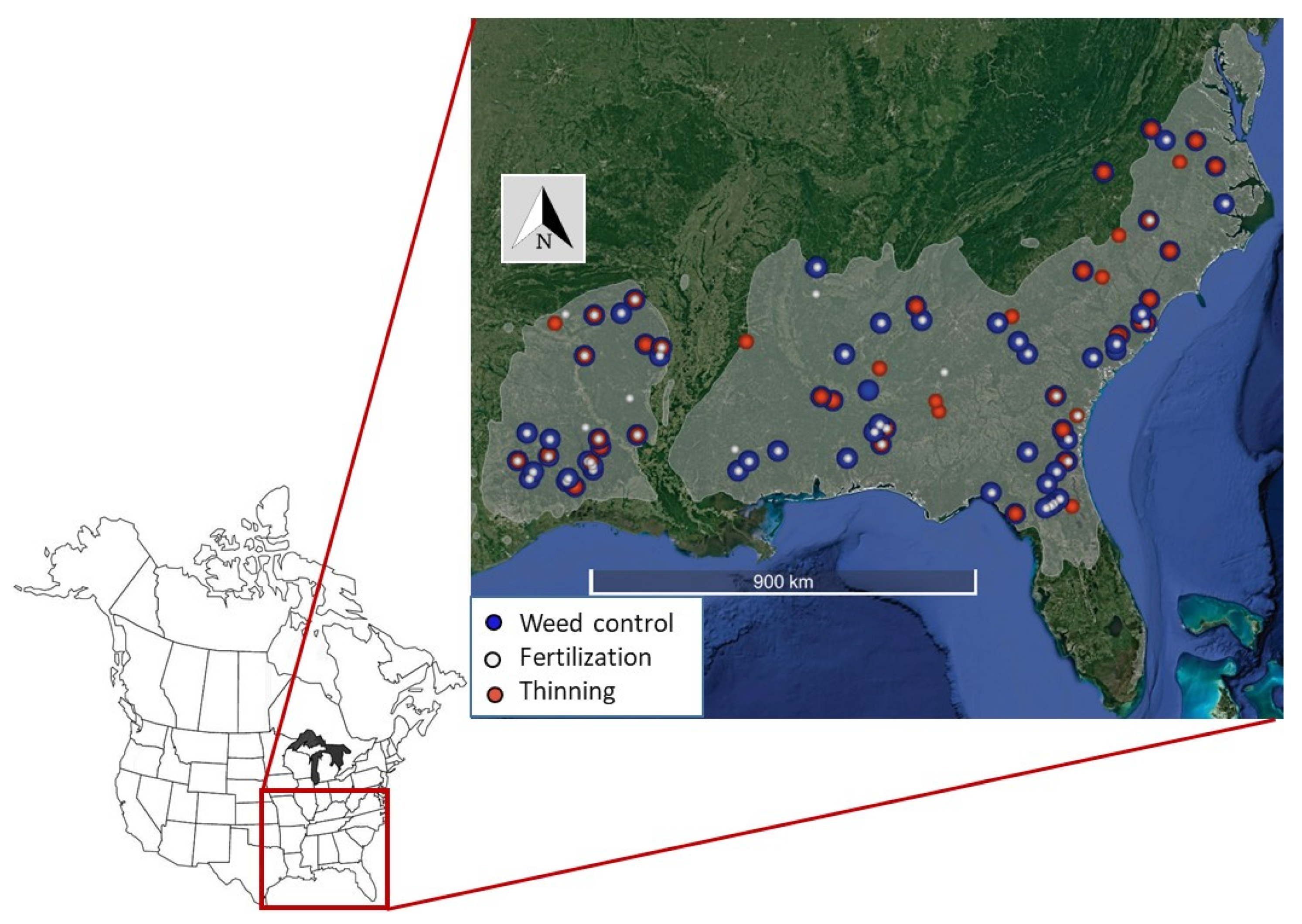
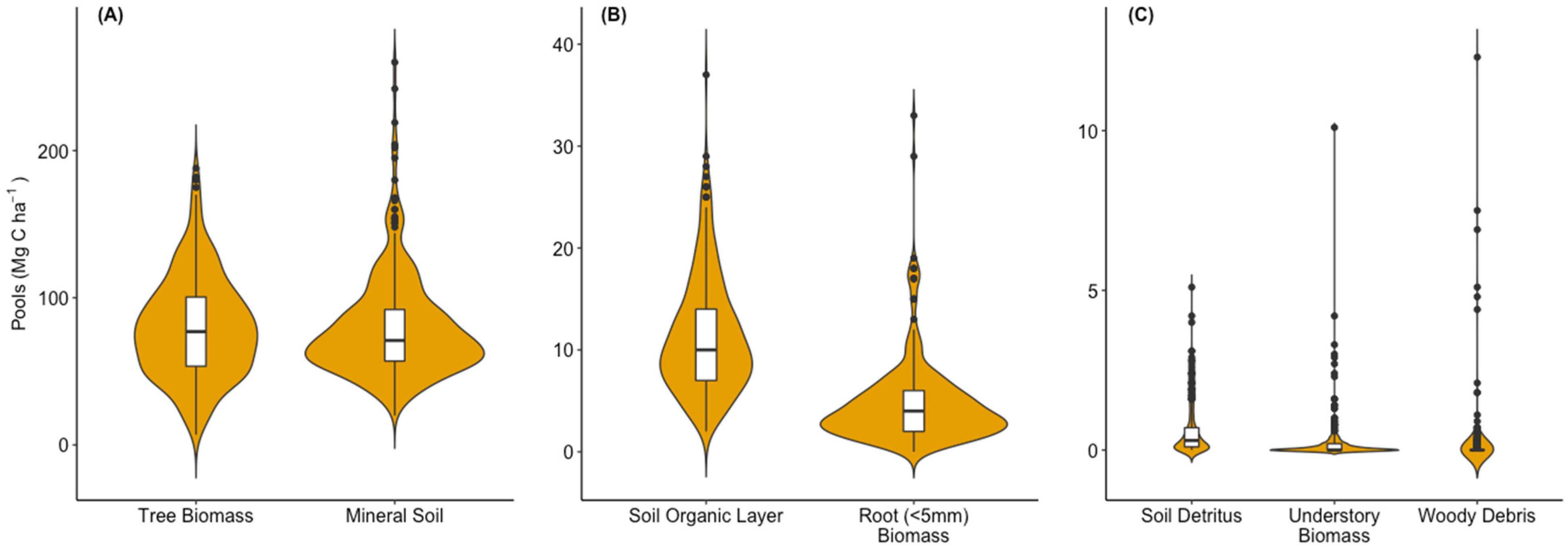
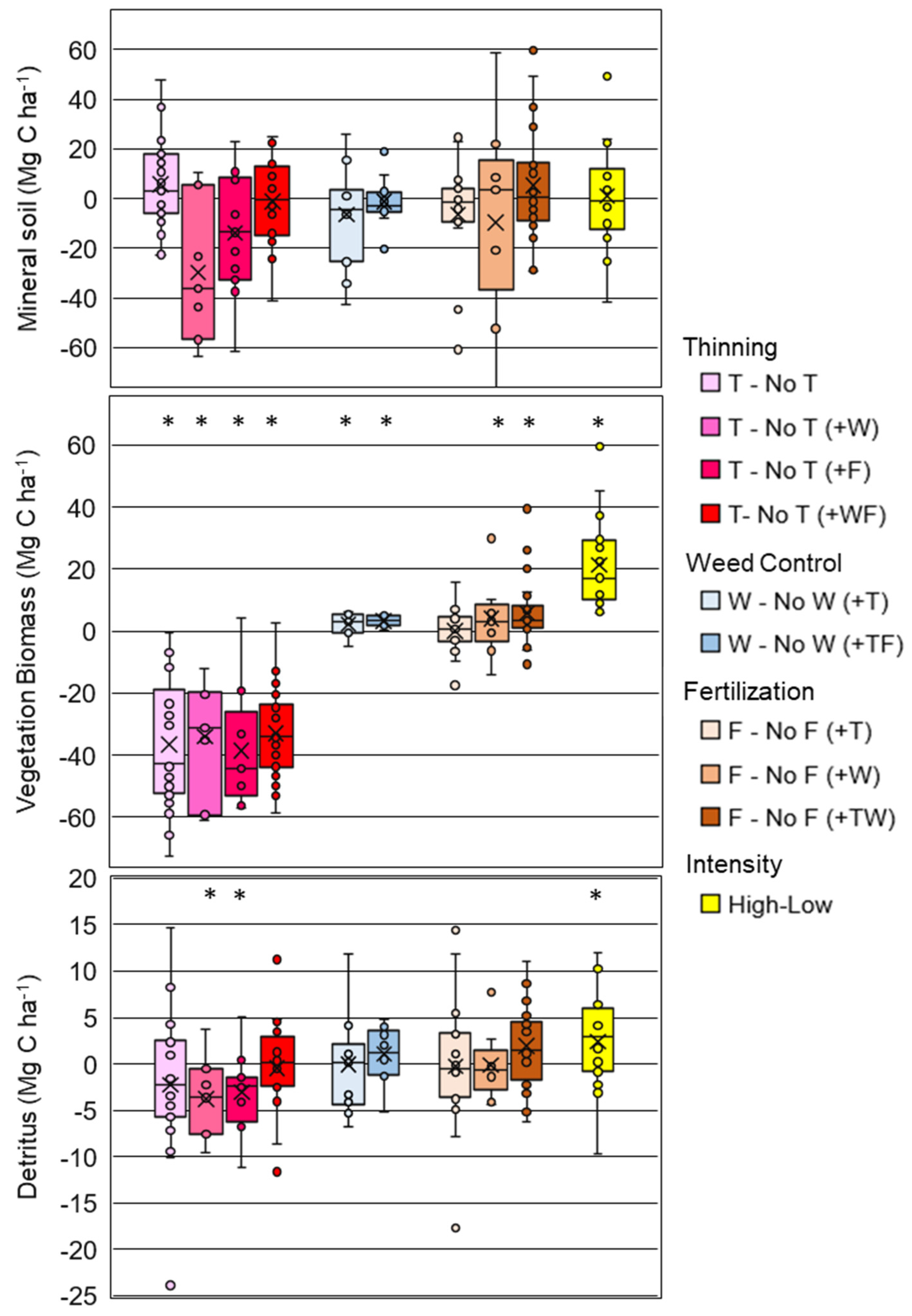
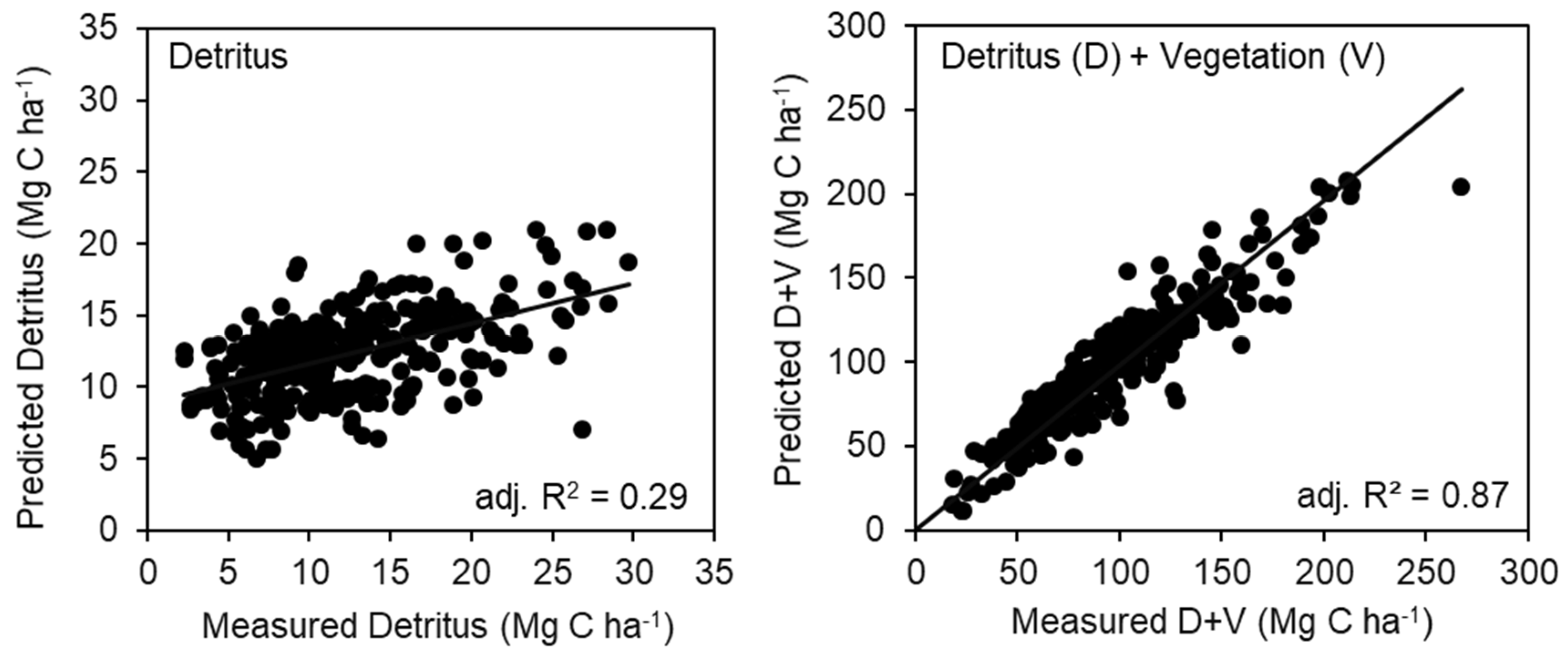
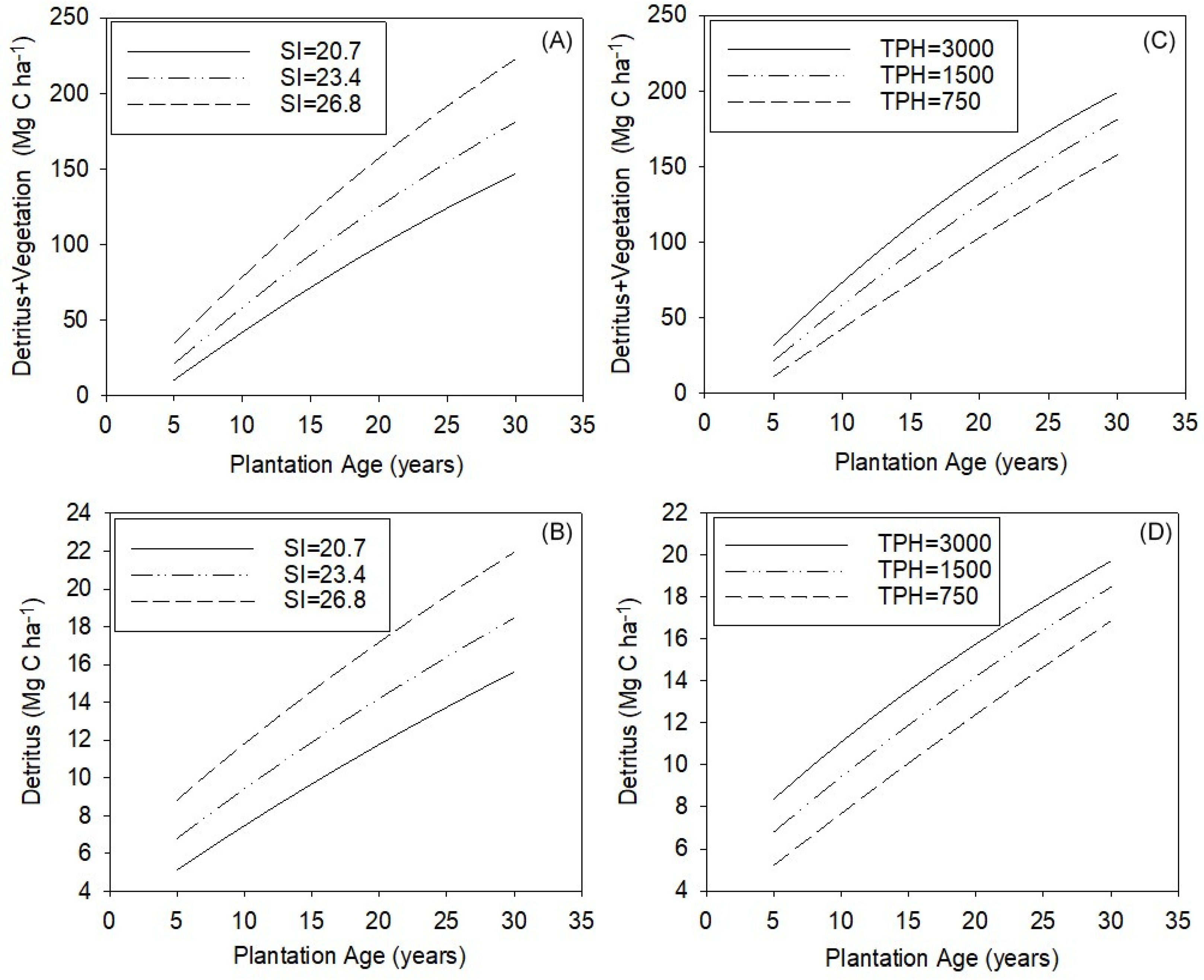
| Age | QMD | BA | TPH | SI | |
|---|---|---|---|---|---|
| Mean | 17 | 20.6 | 29.4 | 1083 | 23.8 |
| Median | 18 | 20.8 | 28.0 | 1044 | 23.6 |
| Min | 2 | 7.8 | 6.1 | 213 | 16.4 |
| Max | 29 | 34.4 | 57.2 | 3956 | 34.0 |
| Treatment | Element | ||||||||||
|---|---|---|---|---|---|---|---|---|---|---|---|
| Comparison | N | P | K | Ca | Mg | S | Mn | B | Cu | Zn | Fe |
| Fertilization vs. No fertilization comparisons | |||||||||||
| F vs. No F (+T) | 312 | 47 | 74 | 27 | 0 | 2 | 0 | 14 | 11 | 0.1 | 0 |
| F vs. No F (+W) | 390 | 29 | 59 | 35 | 19 | 40 | 4 | 1 | 2 | 1 | 13 |
| F vs. No F (+TW) | 320 | 44 | 110 | 57 | 12 | 60 | 45 | 2 | 0 | 0 | 0 |
| Fertilization as a background treatment in other comparisons | |||||||||||
| T vs. No T (+F) | 193 | 41 | 0 | 35 | 0 | 0 | 0 | 0 | 0 | 0 | 0 |
| T vs. No T (+FW) | 214 | 52 | 0 | 57 | 0 | 0 | 0 | 0 | 0 | 0 | 0 |
| W vs. No W (+TF) | 306 | 34 | 0 | 0 | 0 | 0 | 0 | 0 | 0 | 0 | 0 |
| High vs. Low intensity comparison | |||||||||||
| High | 916 | 153 | 91 | 34 | 36 | 68 | 10 | 2 | 4 | 3 | 31 |
| Low | 333 | 75 | 43 | 0 | 0 | 0 | 0 | 0 | 0 | 0 | 0 |
| DF | MSERR | C(p) | adj. R2 | p-Value | |
|---|---|---|---|---|---|
| Detritus (D) | |||||
| D = −9.46 + 0.077 × ln(TPH) × SI + 0.0034 × ln(TPH) × SI × AGE | 299 | 28.3 | 14.3 | 0.29 | <0.001 |
| Detritus + Vegetation (D + V) | |||||
| D + V = −70.23 + 0.30 × ln(TPH) × SI + −2.23 × AGE + −0.13× SI × AGE + 0.077 × ln(TPH) × SI × AGE | 301 | 210.0 | 22.6 | 0.87 | <0.001 |
Publisher’s Note: MDPI stays neutral with regard to jurisdictional claims in published maps and institutional affiliations. |
© 2021 by the authors. Licensee MDPI, Basel, Switzerland. This article is an open access article distributed under the terms and conditions of the Creative Commons Attribution (CC BY) license (https://creativecommons.org/licenses/by/4.0/).
Share and Cite
Vogel, J.G.; Bracho, R.; Akers, M.; Amateis, R.; Bacon, A.; Burkhart, H.E.; Gonzalez-Benecke, C.A.; Grunwald, S.; Jokela, E.J.; Kane, M.B.; et al. Regional Assessment of Carbon Pool Response to Intensive Silvicultural Practices in Loblolly Pine Plantations. Forests 2022, 13, 36. https://doi.org/10.3390/f13010036
Vogel JG, Bracho R, Akers M, Amateis R, Bacon A, Burkhart HE, Gonzalez-Benecke CA, Grunwald S, Jokela EJ, Kane MB, et al. Regional Assessment of Carbon Pool Response to Intensive Silvicultural Practices in Loblolly Pine Plantations. Forests. 2022; 13(1):36. https://doi.org/10.3390/f13010036
Chicago/Turabian StyleVogel, Jason G., Rosvel Bracho, Madison Akers, Ralph Amateis, Allan Bacon, Harold E. Burkhart, Carlos A. Gonzalez-Benecke, Sabine Grunwald, Eric J. Jokela, Michael B. Kane, and et al. 2022. "Regional Assessment of Carbon Pool Response to Intensive Silvicultural Practices in Loblolly Pine Plantations" Forests 13, no. 1: 36. https://doi.org/10.3390/f13010036
APA StyleVogel, J. G., Bracho, R., Akers, M., Amateis, R., Bacon, A., Burkhart, H. E., Gonzalez-Benecke, C. A., Grunwald, S., Jokela, E. J., Kane, M. B., Laviner, M. A., Markewitz, D., Martin, T. A., Meek, C., Ross, C. W., Will, R. E., & Fox, T. R. (2022). Regional Assessment of Carbon Pool Response to Intensive Silvicultural Practices in Loblolly Pine Plantations. Forests, 13(1), 36. https://doi.org/10.3390/f13010036











